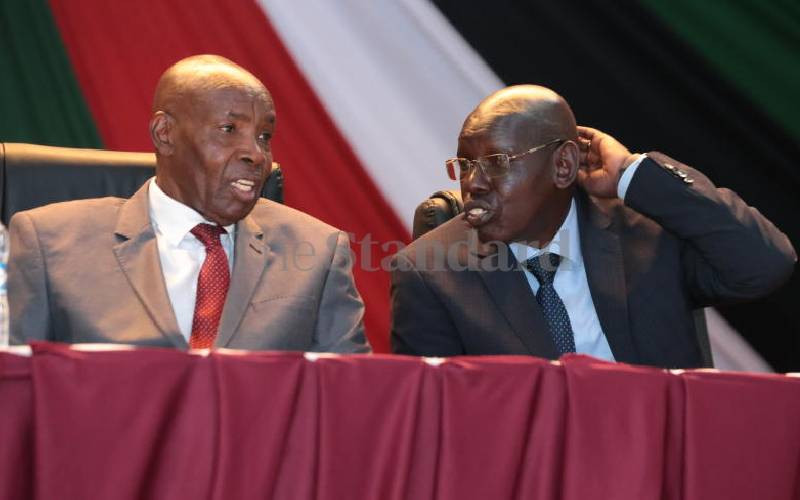
A major overhaul is on the horizon for the more than 10,000 secondary schools in the country that could see significant staff layoffs and funding cuts as the government implements changes to the national curriculum.
The Ministry of Education recently rejected a proposal to move the final year of junior school to secondary schools.
With the anticipated decline in secondary school population, education stakeholders warn schools with excess staff compared to their student population may be forced to consider layoffs.
Kenya National Union of Teachers (Knut) secretary general Coliins Oyuu said this will mainly affect teachers under Board of Management (BoM) contracts and support staff.
The estimated one million students registered for the 2024 Kenya Certificate of Secondary Education (KCSE) exam will leave a significant void, forcing secondary schools to undergo restructuring.
Currently, there are 4.2 million learners in secondary school, according to figures produced before Parliament by the Ministry of Education in March.
However, when the institutions re-open next year, that number will drastically drop to about 3.3 million students.
Giving a glimpse of the impact of the anticipated changes, Basic Education Principal Secretary Belio Kipsang noted the decline in secondary school population would provide a partial solution to funding gaps in the institutions.
While appearing before the Education Committee in the National Assembly, Dr Kipsang said they are facing a Sh22 billion shortfall, attributed to stagnant funding for the last six years despite a surging student population.
The PS said the ministry has been forced to shrink the amount provided as capitation from Sh22,224 to about Sh17,000.
However, he explained that the exit of the 2024 KCSE candidates in November and Form One admission break in 2025 will see the secondary school funding crisis drop from the current Sh22 billion to about Sh11 billion.
“Remember we shall not be having a Form One class so the under-funding will go down to about Sh11 billion and that is what the Education committee is trying to ensure is taken care of in this 2024/2025 financial year," Kipsang said.
The PS assured that the remaining deficit will be provided under the 2024/2025 budget allocation following consultations with the Education committee.
Despite the positive forecast, the decline in student population will also come with a financial sting.
A section of education stakeholders say schools will witness a major deep in finances as the government funds institutions per the number of students.
Government funding for schools, known as capitation, is directly tied to student enrollment. This means the decline will likely lead to a substantial decrease in revenue.
Kenya Union of Post Primary Education Teachers (Kuppet), secretary general Akello Misori, said the institutions will further be hit by a drop in fees paid directly by parents in boarding schools.
Misori has called on the Ministry to ensure funds that have been going to secondary schools are maintained even with exit of these year's candidates to support effective operations.
"Remember the government funding to schools is not sufficient. Maintaining the amount that catered for the outgoing class will cater for the shortfall and we can start correcting the funding mess in our schools," the Kuppet secretary general said in telephone interview.
However, he was optimistic that a silver lining could be the potential easing of the teacher shortage that has long been a challenge in Kenya's education system.
"With fewer students, the existing teacher pool may be sufficient to maintain a healthy student-to-teacher ratio. However, this improvement could come at a cost," said Misori.
While the decline in student population could finally be the unlikely solution to the long-standing teacher shortage that has plagued the institutions for a long time, some stakeholders think it could stretch to job cuts.
Knut secretary general warns that some schools might be forced to lay off staff who were hired on account of the high enrollment in the previous years.
"The services of some teachers employed to plug in arising shortage is no longer needed, and this can see some staff in those institutions laid off," Oyuu said.
National Parents Association chairperson Silas Obuhatsa argues that overcrowding, a longstanding issue in secondary schools, will be significantly reduced.
"This translates to more manageable class sizes, additional space for practical learning, and potentially less strain on boarding school dormitories that have historically faced overcrowding," said Obuhatsa.
The Ministry of Education is yet to release detailed plans for the restructuring process. This lack of clarity causes uncertainty for school administrators, teachers, and parents.
 The Standard Group Plc is a multi-media organization with investments in media
platforms spanning newspaper print
operations, television, radio broadcasting, digital and online services. The
Standard Group is recognized as a
leading multi-media house in Kenya with a key influence in matters of national and
international interest.
The Standard Group Plc is a multi-media organization with investments in media
platforms spanning newspaper print
operations, television, radio broadcasting, digital and online services. The
Standard Group is recognized as a
leading multi-media house in Kenya with a key influence in matters of national and
international interest.



